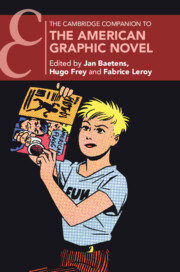Book contents
- The Cambridge Companion to the American Graphic Novel
- The Cambridge Companion to the American Graphic Novel
- Copyright page
- Contents
- Figures
- Contributors
- Editors’ Acknowledgments
- Introduction
- Part I History and Genre
- 1 The “First” Graphic Novel in America
- 2 The Mad-Men Generation
- 3 From Justin Green and Art Spiegelman to Alison Bechdel
- 4 Graphic Journalism
- 5 “Great” American Graphic Novels
- 6 Crime
- 7 Superheroes in Graphic Novels
- 8 Science Fiction and Fantasy
- 9 “Scared Witless”
- Part II Graphic Novels and the Quest for an American Diversity
- Index
- Cambridge Companions To …
- References
8 - Science Fiction and Fantasy
New Works of Imagination
from Part I - History and Genre
Published online by Cambridge University Press: 10 January 2024
- The Cambridge Companion to the American Graphic Novel
- The Cambridge Companion to the American Graphic Novel
- Copyright page
- Contents
- Figures
- Contributors
- Editors’ Acknowledgments
- Introduction
- Part I History and Genre
- 1 The “First” Graphic Novel in America
- 2 The Mad-Men Generation
- 3 From Justin Green and Art Spiegelman to Alison Bechdel
- 4 Graphic Journalism
- 5 “Great” American Graphic Novels
- 6 Crime
- 7 Superheroes in Graphic Novels
- 8 Science Fiction and Fantasy
- 9 “Scared Witless”
- Part II Graphic Novels and the Quest for an American Diversity
- Index
- Cambridge Companions To …
- References
Summary
This chapter scrutinizes two genres that seem closer to the world of comic books than to graphic novels, but that have nevertheless proven extremely influential in the development of the latter. It opens with a definition of both science fiction and fantasy, contrasted genres yet with many shared tropes, and it acknowledges the difficulties of summarizing the specific features of each category. The chapter addresses the most important forerunners of both genres, such as Little Nemo in Slumberland, Buck Rogers, Flash Gordon, or Prince Valiant, whose relevance for the graphic novel is now fully recognized. It aptly analyzes the birth of Action Comics in 1938 as a turning point and the start of the superhero genre with the Superman character, in whom science fiction and fantasy converge (although later forms of both genres also bear the strong influence of crime comics). The chapter also compares the Marvel and DC production and examines the development of franchises, which prove perfectly compatible with the creation of author-oriented graphic novels. Examples of such affinity are The Swamp Thing, The Sandman, Saga, and The Walking Dead.
Keywords
- Type
- Chapter
- Information
- The Cambridge Companion to the American Graphic Novel , pp. 139 - 154Publisher: Cambridge University PressPrint publication year: 2023



